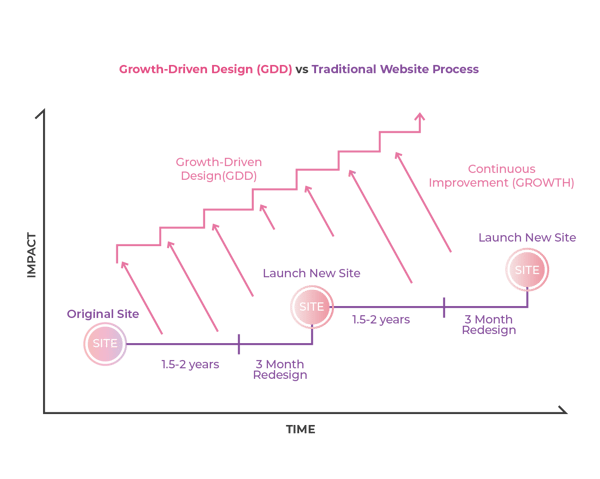Growth-Driven Design (GDD) is a smarter and more powerful approach to website design that reduces risks and drives peak performance. In this blog, we would share what is Growth-Driven Design and how you can apply it to your website, no matter a B2B website or an eCommerce one.
What is Growth-driven Design?
Your website is one of the most important elements of your company’s digital landscape, no matter it is a corporate site or a sales-converting eCommercesite. It is essential to keep your website updated, user-focused, and always optimized. In reality, the average website redesign timeline is around 18-24 months due to the frustrating process. Growth-Driven Design (GDD) offers a smarter and more powerful approach to website design that reduces risks and drives peak performance. In this blog, we would share what exactly is GDD, and how it works.
Growth-Driven Design (GDD) vs Traditional Website Process
Traditional Website Process
Website revamp can be a frustrating process, the most common problems are:
- It requires large up-front cost, time & resource commitment
- It often runs behind schedule or over-budget
- It has an unpredictable Results: subjective designs and no guarantee it will improve performance
The website works properly the moment it launches. After a few months, you start to realize there are new functionalities, technologies or content modules you like to adopt to your website. However, most of the time, the website would sit unchanged for years maybe due to the lack of resources until the next revamp in years.
Fortunately, Growth-driven Design (GDD) can be the cure.
Growth-Driven Design (GDD)
GDD is a progressive approach for designing, building, and optimizing websites. Instead of putting all your eggs in one basket, we can develop and launch the site quickly in a ‘bite-size’ approach. A GDD website can help you reduce the headaches and achieve your principal marketing goals based on user data and continuous experiments.
 GDD approach means post website launch, you can continuously collect data of users’ interaction with your pages to make informed decisions, achieve a faster time-to-value, and return on your investment.
GDD approach means post website launch, you can continuously collect data of users’ interaction with your pages to make informed decisions, achieve a faster time-to-value, and return on your investment.

How Does GDD Work?
Typically, the GDD methodology is a 3-stage-process: Strategy, Launch Pad, and Continuous Improvement.

Stage 1: Strategy
At this phase, you are kicking things off by setting clear and measurable objectives. Try to develop an empathetic approach by understanding how the site can enhance your audience’s buyer journey.
The typical deliverables you can try to achieve in the Strategy stage are:
- SMART Goal
- Perform UX Research
- List out Jobs to be done
- Make Fundamental Assumption
- Develop Buyer Personas
- Map User Journey
- Set Website Strategy
- Form a Wishlist
Stage 2: Launch Pad
Launch pad website is a foundation for further development and optimization. The goal of this phase is to quickly build a fully functioning website that is better than your existing one. This helps you to collect real-user data faster and make more informed decisions.
Firstly, make a priority list of the most useful pages. Next, customize your approach by using different methods, such as refresh, 80/20 method, which identify the 20% of efforts that will have 80% of the impact and value for your website’s users.
Once you have identified the most critical action items, you can create a website launch plan by time-boxing each phase into sprints, which minimize project delays and revision costs.

Stage 3: Continuous Growth
GDD is all about continuous experimenting and optimizing. After the launch website goes live, it will be time to build a repeatable and agile process for the team. This stage is a continuous process which takes around 12 months.

Once you have completed the cycle, it is time to go back to the beginning and start planning your next cycle! The more cycles you complete, the more impact your website is going to have.
GDD Tools
To adopt GDD requires the website CMS to be scalable, allowing you to build the website on a modular basis. So you can launch each sprint with minimum impact to the already launched ones, HubSpot CMS is the solution for B2B website with the powerful features:
- Glean insights about website users
- Run page experiments
- SEO recommendations
- Analyze the impact of the website by analyzing the content
- Integration with lots of tools like SurveyMonkey
GDD for Ecommerce Websites
GDD also works for e-commerce websites. To prepare, you should prepare buyer personas, and gain the user insight from your website analytics, and competitive analysis. Create a wishlist and prioritize what are the must-have features for your eShop. After you are done with your wishlist, you may start working to create your Launch Pad site and collecting the real user data. Applying GDD method would help you take full control of your store and track its performance, providing interesting, relevant, and valuable to your customers, ultimately build a high converting store.
All in all, GDD is an efficient and productive method that helps you achieve your marketing goals effectively by focusing on user data. Admittedly, this process can be challenging, but we are here to help you implemented GDD and inbound marketing. Talk to our specialist to understand more!

